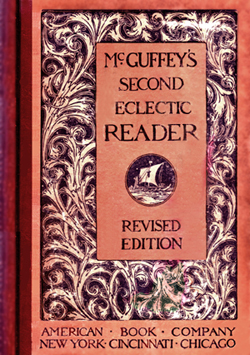Imagine looking in on a one-room school in 1880 infant Johnson City with one teacher instructing six grades. Miss Stern, a strict, priggish schoolmarm is sitting at her desk with a shiny red apple positioned to her right.
The old institution of lower education is reflective of the times: a school bell regimenting the students’ activities, potbellied stove nearby, water bucket in one corner, slate chalkboard along the front wall, dunce stool and wooden paddle present – all necessary instructional tools. Notably absent is an inside bathroom.

Miss Stern beckons her impish class to get out their McGuffey’s Second Eclectic Reader, Revised Edition, for the day’s lesson. The smallish 160-page glossy page reader contains 71 short lessons, most containing an impressive black and white detailed illustration. The preface instructs the educator to look closely at each picture and include such observations with the lesson.
Teacher Stern next asks her pupils to turn to lesson 14, “Henry the Bootblack.” She commences by going over the pronunciation and meaning of 17 new words contained in the text. Included are “support,” “money,” “blacking,” “boots,” “belong” and “manage.” The storyline entails Henry, a kind young boy whose widowed mother must labor hard to care for her son and daughter. After Henry finds a wallet stuffed full of money and returns it to the rightful owner, he is rewarded with a dollar.
The currency allows him to buy a bootblack box, three brushes and blacking. His acute politeness to customers in his new job earns him much business, which greatly supplements his mother’s meager income. The sketch in the lesson shows the shabbily dressed Henry and an immaculately attired male customer wearing a derby hat. The lad’s box and contents can be seen laying on the sidewalk next to the curb.
McGuffey readers appeared on the scene in 1836 when a Cincinnati publishing house released the first four Eclectic Readers that were selected by an Ohio schoolteacher and a teacher/ preacher named William Holmes McGuffey. Eventually, there were six readers, a primer and a spelling book.
Although McGuffey is credited for authoring the first four Readers in 1836 and 1837, his brother Alexander produced the last two volumes during the 1840s. The Readers emphasized spelling, vocabulary, and formal public speaking. An estimated 120 million readers sold between 1836 and 1960.
The product dominated the elementary textbook scene through the turn of the last century, undergoing numerous edition changes. The primary focus of the authors seemed to be stressing life’s values. The carefully chosen selections of prose and poetry from such masters of literature as John Milton, Daniel Webster and Lord Byron, as well as others, taught youngsters true patriotism, integrity, honesty, industry, temperance, courage, politeness and other moral and intellectual virtues.”
McGuffey's Readers were among the first textbooks in America that were designed to become progressively more challenging with each edition. The readers employed repetition in the text as a learning tool, which built strong reading skills through challenging reading. McGuffey died in 1873. Although the little books went out of vogue in the educational community many years ago, about 30 thousand books are sold annually to public, private and home schools.
These little quaint nostalgic didactic reminders of rural 19th century Americana are a significant part of our rich heritage.

Comments are closed.